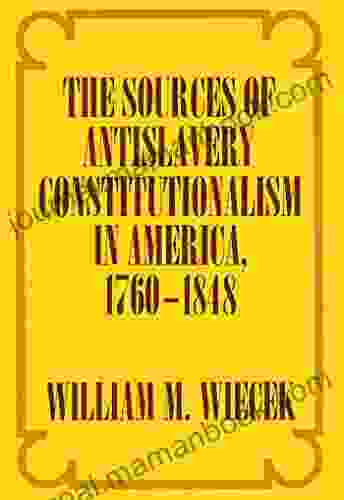The Sources of Anti-Slavery Constitutionalism in America, 1760-1848

The abolition of slavery in the United States was a long and arduous process that began in the colonial era and culminated in the Civil War. The origins of anti-slavery constitutionalism in America can be traced back to the Enlightenment, which emphasized the natural rights of individuals and the importance of limited government. These ideas were enshrined in the Declaration of Independence, which proclaimed that "all men are created equal" and that they are endowed with certain unalienable rights, including the right to life, liberty, and the pursuit of happiness.
The Declaration of Independence was a powerful statement of principles, but it did not immediately lead to the abolition of slavery. In fact, slavery continued to be legal in the United States for nearly a century after the Declaration was adopted. However, the Declaration did provide a moral and philosophical foundation for the anti-slavery movement.
4.7 out of 5
| Language | : | English |
| File size | : | 861 KB |
| Text-to-Speech | : | Enabled |
| Enhanced typesetting | : | Enabled |
| Word Wise | : | Enabled |
| Print length | : | 309 pages |
| Screen Reader | : | Supported |

Early Anti-Slavery Movements
The first organized anti-slavery movements in America emerged in the 1760s. These movements were led by religious groups, such as the Quakers and Moravians, who believed that slavery was a sin. Anti-slavery activists also argued that slavery was economically inefficient and that it undermined the republican ideals of liberty and equality.
In 1777, Vermont became the first state to abolish slavery. This was followed by Massachusetts in 1783 and New Hampshire in 1784. However, slavery continued to be legal in the Southern states, where it was an essential part of the economy.
The Constitutional Convention
The Constitutional Convention, which met in Philadelphia in 1787, debated the issue of slavery. Some delegates, such as Benjamin Franklin and James Madison, argued that slavery should be abolished. However, other delegates, such as George Washington and John Rutledge, argued that slavery was necessary for the Southern economy.
In the end, the Convention reached a compromise on the issue of slavery. The Constitution did not explicitly abolish slavery, but it did prohibit the importation of new slaves into the United States. The Constitution also gave Congress the power to regulate the slave trade.
The Abolitionist Movement
The abolitionist movement gained momentum in the early 19th century. Abolitionists argued that slavery was a moral evil and that it had no place in a free republic. They also argued that slavery was economically inefficient and that it undermined the republican ideals of liberty and equality.
Abolitionists used a variety of tactics to promote their cause. They published newspapers and pamphlets, gave speeches, and organized protests. They also worked to help slaves escape to freedom.
The abolitionist movement faced strong opposition from pro-slavery forces. Pro-slavery forces argued that slavery was a necessary evil and that it was essential for the Southern economy. They also argued that abolition would lead to racial violence and social unrest.
The Civil War
The Civil War began in 1861 when Confederate forces fired on Fort Sumter in South Carolina. The war was fought over the issue of slavery, with the Union states fighting to preserve the Union and the Confederate states fighting to preserve slavery.
The Civil War was a long and bloody conflict that resulted in the deaths of over 600,000 Americans. In 1863, President Abraham Lincoln issued the Emancipation Proclamation, which freed all slaves in the Confederate states. The Emancipation Proclamation was a major turning point in the war, and it helped to ensure that the Union would eventually prevail.
The Civil War ended in 1865 with the defeat of the Confederacy. The war led to the abolition of slavery in the United States and the passage of the Thirteenth Amendment to the Constitution, which prohibited slavery in all of the United States.
The sources of anti-slavery constitutionalism in America can be traced back to the Enlightenment, which emphasized the natural rights of individuals and the importance of limited government. These ideas were enshrined in the Declaration of Independence, which proclaimed that "all men are created equal" and that they are endowed with certain unalienable rights, including the right to life, liberty, and the pursuit of happiness.
The abolition of slavery in the United States was a long and arduous process that began in the colonial era and culminated in the Civil War. The early anti-slavery movements were led by religious groups, such as the Quakers and Moravians, who believed that slavery was a sin. Anti-slavery activists also argued that slavery was economically inefficient and that it undermined the republican ideals of liberty and equality.
The abolitionist movement gained momentum in the early 19th century. Abolitionists argued that slavery was a moral evil and that it had no place in a free republic. They also argued that slavery was economically inefficient and that it undermined the republican ideals of liberty and equality.Abolitionists used a variety of tactics to promote their cause. They published newspapers and pamphlets, gave speeches, and organized protests. They also worked to help slaves escape to freedom.
The Civil War was a long and bloody conflict that resulted in the deaths of over 600,000 Americans. In 1863, President Abraham Lincoln issued the Emancipation Proclamation, which freed all slaves in the Confederate states. The Emancipation Proclamation was a major turning point in the war, and it helped to ensure that the Union would eventually prevail.
The Civil War ended in 1865 with the defeat of the Confederacy. The war led to the abolition of slavery in the United States and the passage of the Thirteenth Amendment to the Constitution, which prohibited slavery in all of the United States.
4.7 out of 5
| Language | : | English |
| File size | : | 861 KB |
| Text-to-Speech | : | Enabled |
| Enhanced typesetting | : | Enabled |
| Word Wise | : | Enabled |
| Print length | : | 309 pages |
| Screen Reader | : | Supported |
Do you want to contribute by writing guest posts on this blog?
Please contact us and send us a resume of previous articles that you have written.
 Top Book
Top Book Novel
Novel Fiction
Fiction Nonfiction
Nonfiction Literature
Literature Paperback
Paperback Hardcover
Hardcover E-book
E-book Audiobook
Audiobook Bestseller
Bestseller Classic
Classic Mystery
Mystery Thriller
Thriller Romance
Romance Fantasy
Fantasy Science Fiction
Science Fiction Biography
Biography Memoir
Memoir Autobiography
Autobiography Poetry
Poetry Drama
Drama Historical Fiction
Historical Fiction Self-help
Self-help Young Adult
Young Adult Childrens Books
Childrens Books Graphic Novel
Graphic Novel Anthology
Anthology Series
Series Encyclopedia
Encyclopedia Reference
Reference Guidebook
Guidebook Textbook
Textbook Workbook
Workbook Journal
Journal Diary
Diary Manuscript
Manuscript Folio
Folio Pulp Fiction
Pulp Fiction Short Stories
Short Stories Fairy Tales
Fairy Tales Fables
Fables Mythology
Mythology Philosophy
Philosophy Religion
Religion Spirituality
Spirituality Essays
Essays Critique
Critique Commentary
Commentary Glossary
Glossary Bibliography
Bibliography Index
Index Table of Contents
Table of Contents Preface
Preface Introduction
Introduction Foreword
Foreword Afterword
Afterword Appendices
Appendices Annotations
Annotations Footnotes
Footnotes Epilogue
Epilogue Prologue
Prologue Susanna Gregory
Susanna Gregory Richard A Lougy
Richard A Lougy Scott Lobdell
Scott Lobdell Margaret Read Macdonald
Margaret Read Macdonald Ken Johns
Ken Johns Khyiah Angel
Khyiah Angel Chris Werner
Chris Werner Robert Rosenfeld
Robert Rosenfeld Stephanie Stein Crease
Stephanie Stein Crease Devin Lee
Devin Lee L Elizabeth Forry
L Elizabeth Forry David Newton
David Newton Kenna Mckinnon
Kenna Mckinnon Jennifer W Aube
Jennifer W Aube Robert Crawford
Robert Crawford Brittney Martin
Brittney Martin Richard Turbet
Richard Turbet Susan Henderson
Susan Henderson Alex Allen
Alex Allen Mihail Sebastian
Mihail Sebastian
Light bulbAdvertise smarter! Our strategic ad space ensures maximum exposure. Reserve your spot today!

 Brady MitchellThe Silent Sea: The Oregon Files – Unraveling the Enigmatic Depths of a Lunar...
Brady MitchellThe Silent Sea: The Oregon Files – Unraveling the Enigmatic Depths of a Lunar...
 Edgar HayesA Concise Guide for Teachers and Parents: Fostering Literacy in Children with...
Edgar HayesA Concise Guide for Teachers and Parents: Fostering Literacy in Children with... Francis TurnerFollow ·19.7k
Francis TurnerFollow ·19.7k Benji PowellFollow ·2.8k
Benji PowellFollow ·2.8k Julio CortázarFollow ·17.9k
Julio CortázarFollow ·17.9k Darius CoxFollow ·13.7k
Darius CoxFollow ·13.7k Yasushi InoueFollow ·5.8k
Yasushi InoueFollow ·5.8k Eugene ScottFollow ·19.1k
Eugene ScottFollow ·19.1k Graham BlairFollow ·16.3k
Graham BlairFollow ·16.3k Roland HayesFollow ·9.4k
Roland HayesFollow ·9.4k

 Alexandre Dumas
Alexandre DumasFugitive Telemetry: Unraveling the Secrets of the...
In the realm of...

 Caleb Carter
Caleb CarterBlack Clover Vol 25: Humans and Evil - A Journey into the...
Unveiling the Sinister Forces Black...

 Israel Bell
Israel BellHow to Make Offers So Good People Feel Stupid Saying No
In today's competitive business environment,...

 Simon Mitchell
Simon MitchellWrath of Hades: The Children of Atlantis
An Epic Tale of...

 Percy Bysshe Shelley
Percy Bysshe ShelleyStrengthen Your Immune System: Fight Off Infections,...
What is the...

 Clark Bell
Clark Bell10 Things I Wish Someone Had Told Me Earlier
As we navigate through life, we accumulate a...
4.7 out of 5
| Language | : | English |
| File size | : | 861 KB |
| Text-to-Speech | : | Enabled |
| Enhanced typesetting | : | Enabled |
| Word Wise | : | Enabled |
| Print length | : | 309 pages |
| Screen Reader | : | Supported |







